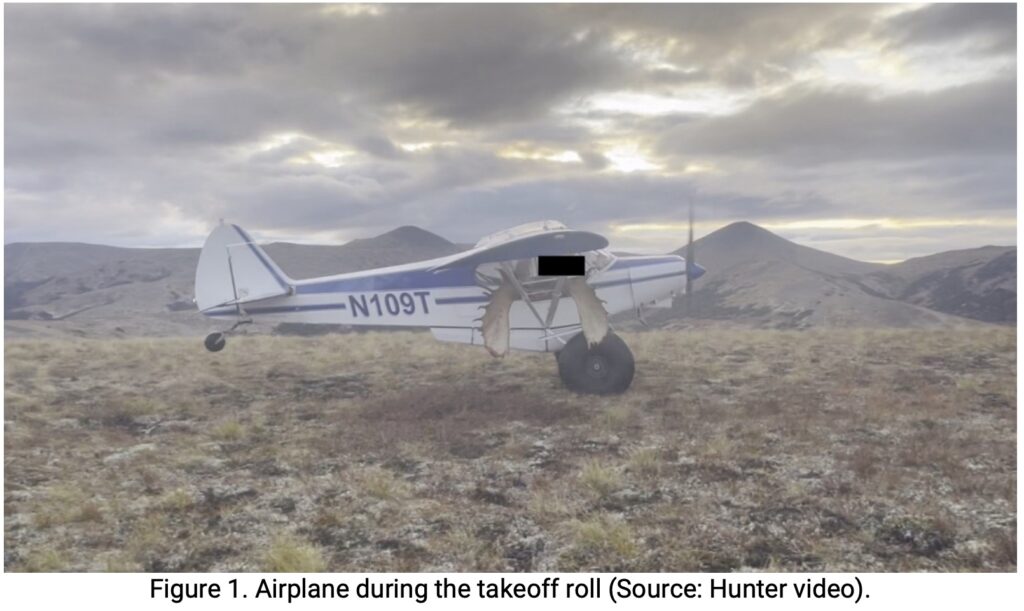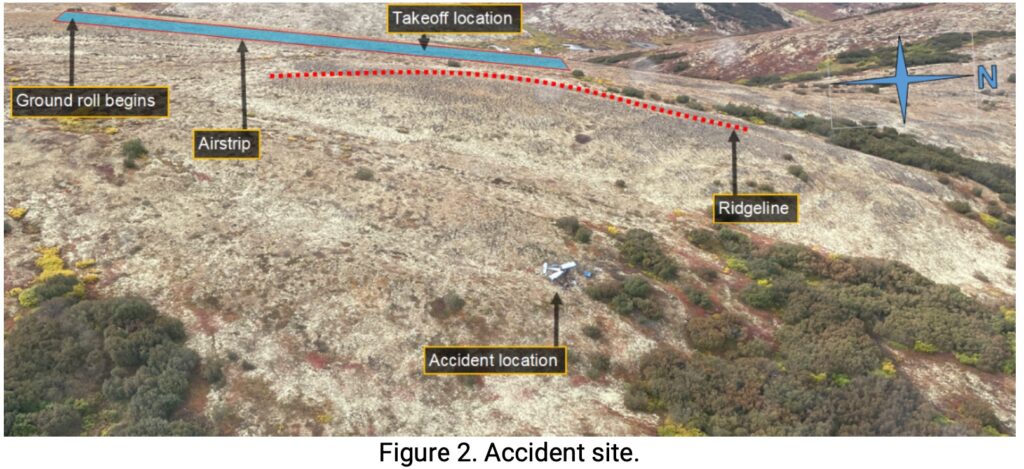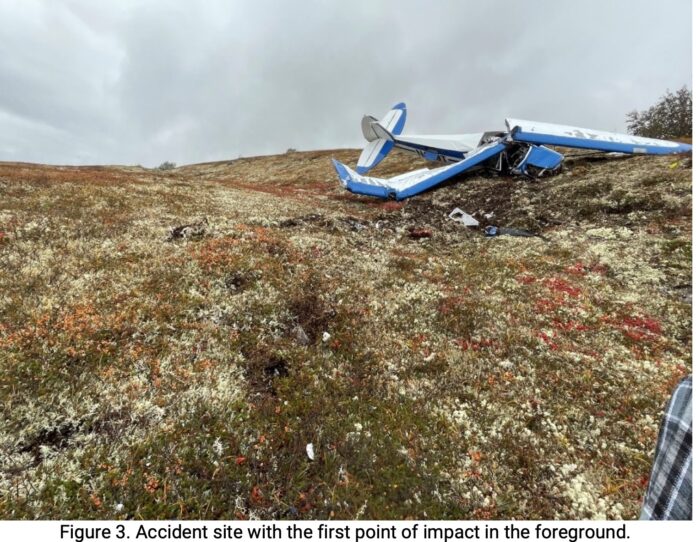The National Transportation and Safety Board has issued a preliminary report filled with details about the plane crash that took the life of Eugene Peltola, husband of Rep. Mary Peltola, on Sept. 12, 2023.
On that day at about 8:47 pm, a Piper PA-18-150, tail number N109T, sustained substantial damage when it crashed near St. Mary’s. Eugene Peltola, the pilot and lone occupant of the plane, died in that crash.
Two days before the accident, Peltola had flown a group of five hunters, a guide, and their equipment from a lodge’s airstrip in Holy Cross. The group set up camp next to the landing strip, which was oriented north-south within hilly terrain about 80 miles northwest of Holy Cross.

The group planned to hunt for a moose and take it back to the lodge at Holy Cross. During the day before the accident, the group successfully hunted a moose and coordinated with the Peltola via satellite messaging devices to ferry the meat the next day.
On Sept. 12, Peltola arrived at the camp about 3:40 pm. Peltola and the hunters loaded the airplane with the first batch of meat, and the airplane departed to the north from the airstrip.
After takeoff, the airplane made an uneventful climbing right turn over an adjacent ridgeline that paralleled the airstrip to the east and then continued in the general direction of Holy Cross.
Peltola returned to camp about 7:40 pm for the second and final load of meat.
During the next hour, Peltola and the hunters loaded the airplane with the meat. One of the hunters reported that the airplane held about 50 to 70 pounds more meat than during the previous flight. Later it was determined there was about 520 pounds of cargo, mostly moose meat and antler.
The meat was strapped into the rear passenger seat area with both the seatbelt and rope and was loaded into the airplane’s belly pod, which did not have tie-down provisions. The pilot then tied the antlers to the right wing strut; the antlers were cupped outward and perpendicular to the direction of flight.

Peltola told a hunter that he had performed fuel calculations and would be at reserve fuel levels on arrival at Holy Cross. They discussed the weather and observed that the wind at the airstrip was generally calm and from the north but that the wind was also intermittently variable and gusting.
Members of the group reported to Peltola that the wind was gusting much stronger at the departure end of the airstrip.
Peltola then boarded the airplane and positioned it for a departure to the north. The hunters noticed that the ground roll was slightly longer than before, and that the airplane appeared to be more “labored” than during the previous flight.
They stated that, as the airplane reached the end of the airstrip, it pitched up and turned sharply to the right but, rather than climbing as before, the airplane flew behind the adjacent ridgeline and out of view. The group initially thought that the pickup had been successful, but the airplane did not reappear from behind the ridge. The group ran to the top of the ridgeline, looked down, and saw that the airplane had crashed.
One of the hunters approached the accident site and found Peltola still conscious. The hunter activated the SOS feature on his satellite messenger device, but the pilot succumbed to his injuries within two hours of the accident.
The airplane’s emergency locator transmitter activated during the accident, and an alert signal was received by the Alaska Rescue Coordination Center about 8:48 pm. According to the hunters, an Alaska Air National Guard team arrived at the accident site via helicopter between 1:30 and 2 am on Sept. 13.
One of the hunters recorded a video of the accident takeoff. The video showed that the airplane began the ground roll at the southern end of the airstrip and departed to the north and uphill. The flaps were retracted, and the tail of the airplane came up as soon as the pilot applied engine power (see figure 1).
The ground roll lasted about 530 feet, and, immediately after takeoff, the airplane pitched up and rolled about 20 degrees to the right. The airplane then appeared to roll to a wings level attitude.
The video ended a few seconds later and it did not capture the accident. The engine was heard operating during the recording, and the airplane was not trailing smoke or vapors.
NTSB inspectors arrived on Sept. 15. Examination revealed that the airplane came to rest on a 30-degree downward slope on the other side of the adjoining ridge line, at an elevation of 1,210 feet mean sea level, about 10 feet lower, and 600 feet east of the departure end of the airstrip (see figure 2).
The surrounding area consisted of rolling hills covered in tundra, grass, and low-lying shrubs and bushes.
The fuselage was on a north heading, and both wings remained partially attached and generally in line with each other on a northwest-southeast orientation. The first identified point of impact, which was located about 20 feet below the main wreckage, consisted of a divot in the soil that contained blue and white fragments that matched the right wingtip (see figure 3).
Next, the right wing landing light assembly and right window frame were located about 5 ft uphill in a west direction. A large divot in the soil, which was located 5 ft farther uphill, matched the general dimensions of a main landing gear tire. Adjacent to this hole was the propeller, which had separated from the crankshaft.
Inspectors say the engine contained oil, and there was no evidence indicated a catastrophic engine failure.
Although the wing tank fuel lines had been breached, residual quantities of fuel were observed in both tanks. Both propeller blades exhibited similar damage, including tip twist, leading-edge nicks and dents, trailing-edge S-bending, and chord-wise scratches.
The airplane cargo was weighed at the accident site, revealing a load of about 520 pounds that consisted primarily of moose meat and a set of moose antlers.
About 150 pounds of meat was found in the forward section of the belly pod; the remaining portions were firmly secured in the rear cabin seating area. The antlers were secured to the inboard side of the right-wing strut.

A sad story of an overweight aircraft crash and death of the pilot. To common in Alaska. How many small aircraft deaths have there been during the 2023 hunting season in Alaska? Only difference here is the Pilot, is the husband of a U.S. Congresswomen. May he rest in peace.
That must have been one big moose. The second load was about 50 to 70 pounds more meat than the first and there was about 520 pounds of cargo on the second flight, including the antlers…almost 1,000 pounds of meat and antlers? Sounds like a couple moose to me.
I am not a pilot but have flown on many small aircraft bush flights (on much stronger aircraft).
The difficulty during takeoff and the eventual failure would not have occurred without the additional weight and out of balance the rack hanging on the right side struts caused. (in my opinion only)
Supercubs are workhorses but not cargo trucks.
More than once I was told the horns cant go on this trip but we can come back for them if they are more important than safety. I never had a problem leaving them behind as I never was hunting horns but these individuals obviously were and it cost them dearly.
They will not likely make that mistake again.
Another very simple method of reducing that 1000 pounds of meat by at least a 100# was by deboning in the field which we always did when using aircraft.
The larger bones on a moose or two that size could have made the difference of life and death in this case if not done. It doesnt take long and it always made the pilot smile.
Nah, you don’t need to debone the meat, you just make another trip.
Anyone that has lived in Alaska for many years has heard this same sad story over and over again. Condolences ?
Too many Alaskan Pilots playing Russian Roulette. Lost everything over a pile of Moose Meat and horns. Fly by the Book, and be PROUD that you do.
Excellent write-up. Doesn’t sound too heavy given the reduced amount of fuel on the second take off. It sounds like a lack of speed and stall during the roll/ climb. Pilot error given the conditions present.
Well, that’s certainly not a light cub.
Let’s say the cub weighs 1200 pounds empty, it could be more on those 35s, but for arguments sake, let’s say 1200.
Pilot probably weighs at least 225.
520 pounds of moose meat.
An hour of fuel plus a little reserve, so, 70-80 pounds there.
That’s a 2015 pound cub, using conservative estimates on pilot,
plane, and fuel weight.
Did they weigh the antlers? A set that size could be 75 pounds green. Regardless of whether that is already included in the 520 pounds of moose meat, that’s a fair bit of weight and drag out there.
Can the supercub do it? Hell yeah it can, but you need to be paying attention and keep everything up else in your favor.
Should’ve taken another trip. Split the antlers and haul them with some gear the next day.
Death by moose meat. In some ways, a fitting way for an Alaskan to die.
Suzanne, another excellent article with much factual data to still be interpreted. Two things which need more examination, if possible:
1. The direction of the wind and the wind speed near the end of the runway.
2. Amount of daylight at 8:45 pm.
.
If the load was well secured, as not to present weight-shifting during take-off, the 520 pounds is within the Super Cub’s maximums. From the diagram presented, Peltola may have begun his right turn too early. Without letting the plane climb-out straight through to gain speed, a hard early turn on a loaded plane will cause: drop in elevation, and a potential stall. He crashed on the backside of the ridge, which means he didn’t have the time, or the elevation, to save himself.
It can be over in mere seconds.
.
From the appearance of the wrecked plane, he landed pretty much nose-in at a fairly low speed. The back half of the fuselage and tail assembly are largely intact. Wings were not stripped completely off. It looks like a lower impact speed which allowed Peltola to survive for a couple hours from his injuries.
.
Another question, was he going to make a return back to the hunters before dark? If yes, the flight was a hurry-up operation to beat darkness. This is never a good thing because it pushes the pilot to do things that can go bad quickly. The ridgeline he crossed over may have interfered with his visual horizon.
.
Thanks again for great information. The preliminary, and forthcoming NTSB final report will provide valuable data which other pilots will use to avoid tragedies such as this one.
Glad we agree. It can be little else given the engine was running and the props showed rotation on impact. The ridge winds usually do cause some turbulence but he was a bush pilot right?
Well. Then sounds like peltola needed to learn patience to make multiple trips taking lighter loads. He could had charge it to the hunters billing for their meat. I met too many Alaskan employees who became leaders of workplaces much too fast before they learned patience and how to talk to their team and customers. It’s better and safer to stay in one company to learn everything developing patience slowly rising up into management. Taking your time so you know how to talk to people like disagreeable hunters acting like a brat that may whine at paying for extra trips for the cargo. Then you know how to train an efficient team and manage the work and supplies costing less for the company. It’s too late for Peltola. Sounds like he needed to make multiple trips with smaller loads charging the extra runs to the hunters for their meat.
Alert the media: Jen comments without reference to Jesus!
Lol.
You’re doing it again.
You are on target with details of the variable wind speed(with gusting and direction at upper end of takeoff which NTSB will never know.
Afternoon and Evening hours in Alaska is common for winds to develop especially in mountainous terrain and over bodies of water.
Witnesses reported the plane made a sudden 20 degree roll to the right immediately on liftoff but then leveled out which could have possibly been a gust of wind from the left and with the added out of center weight added to the right side by the heavy antlers.
That alone could have interrupted the ability to achieve the climbing speed needed.
There was a common description of the wind in bush Alaska. “The wind will stop blowing long enough to change directions”
Jim Tweto met his end under those exact conditions. Erratic wind direction and gusting reported by the helicoptor pilot earlier that day.
So, a question:
Is that roll-out in Figure #1 taken on the first moose meat transfer, or the second? There appears to be too much daylight left at 8:45pm on September 13th. Check the daylight hours for 9/13. Sun had already set. I think that photo may have been taken on the first moose meat haul-out. Just guessing, though.
Most probably the accident takeoff – I doubt if the feds posted a picture otherwise. Some cameras automatically enhance lowlight photos.
The daylight hours are much different in Holy Cross than Anchorage.
Date Sunset End of Civil Twilight
Wed, Sep 13 9:11:57 pm 9:55:28 pm
Has the autopsy blood test been done? With a guy nicknamed Buzzy, gotta wonder if a buzz was going on that contributed to the crash.
See. You readers got mad at Sarge Rudd for speaking honestly how small aircraft pilots are today. His observations are spot on. Peltola make bad most unfortunate decision stuffing his little plane. Now you owe Sarge Rudd an apology.
Thank you Jen.
Earlier reports in the media stated: “The plane that crashed was not registered in Peltola’s name.” However, they did not divulge who it was registered to. Was Peltola operating the aircraft under contract for the Werba’s business (Alaska Pike) or an actual employee. Not that it matters that much since the outcome is the same.
NOTE: the registered owner of this 1952 PA-18-150 aircraft with Tail Number N109T is Bruce J. Werba (Holy Cross). Last Action Date 2022-07-27. Expiration 2025-07-31.
Per the FAA: same owner (Bruce J. Werba), but expiration date for certificate expiration is 7/31/2029. No fractional owner (e.g. Peltola). Bruce is co-owner of a business with his wife Connie called Alaska Pike Safaris and Wilderness Adventures LLC. Entity #: 10090554 (Alaska Corporation Database search results).
‘https://www.alaskapike.com/guided-innoko-moose-hunting
Also see
‘https://www.flightaware.com/resources/registration/N109T
AND
‘https://registry.faa.gov/AircraftInquiry/Search/NNumberResult?nNumberTxt=109T
Seems like anyone who has something to tell is “tragically” in a “accident”…who was it that said there’s no such thing as coincidences? Cough…
According to the witnesses, the plane suddenly pitched up – did the 150 pounds of meat in the belly pod shift as the plane took off? Just wondering, as a cargo shift as the plane was taking off would look a lot like what was described. At any rate, sorry to see that fate is still the hunter. Sorry for Mary and sorry for the bush pilot community in Alaska, and all that knew this fine man.
I have hauled moose antlers on Super cub wing struts but never had them
strapped on like the ones on Peltola’s plane.
These were strapped on in such a way that they might cause a great deal
of drag on the right side of the plane which could have disrupted the flow of air over the elevator and rudder. The fact that the plane abruptly pitched up and then stalled might have been caused in part by these antlers. And in part by an aft or shifting loading that might have put the weight behind the acceptable aft center of gravity limit.
Hey first, your onto something. The weight wasn’t a issue, but the drag caused by the antler was certainly a contributing factor.
That’s why cargo is supposed to be inside the aircraft. Otherwise, Piper would have an approved luggage rack on the top for outsized cargo. It’s an airplane, not a truck.
I just cannot get over the coincidence of this airplane crash fatality AND Dianne Feinstein’s “untimely” death also during the time when the O’biden Impeachment Inquiry is going on. Remember all those white house thugs traveling to Alaska just weeks ago? I understand that Alaska does have many legit, pilot error airplane crashes; doesn’t that make a great cover story? Can you really trust a government agency’s findings on congress person’s spouse’s death? Who were the hunters? As someone else pointed out, who was the plane registered to? Is there a possibility that there was a mechanical issue that did not show up until the load was close to, or at, maximum?
Maybe the aliens were involved.
Of course! Aliens! I forgot about the aliens! I have not heard any alien stories for Alaska yet.
Comments are closed.